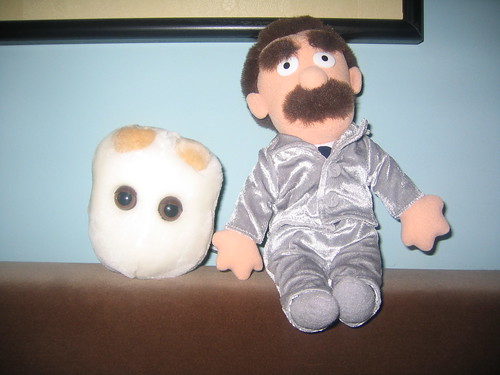Bear Essentialism
Language often poses hurdles to understanding. Quine was correct when he noted that linguistic and mental meaning are partly constructed by practices of interpreting and translating. To paraphrase the trite question from epistemology 102, how do we know that two people understand the same concept when they hear the word "teddy bear?"
Long time readers of this blog might have noticed a certain terminological infelicity with regards to the term "teddy bear." Harriet's usage has always been broad and catholic encompassing bears as well as ardvarks, armadillos, dogs, ducks, eagles, lobsters, moose, owls, pigs, possums, rabbits, turtles, and zebras. It is fair to say that Harriet applies the term "teddy bear" (or even "bear") to any and all furry or fuzzy animals. In contrast, some utilize "teddy bear" solely in reference to animals strictly ursine in nature. The broader spectrum of the kingdom falls under the category "stuffed animal" or "plush toys." Such differences are of no consequence and I mention them merely to dispose of a potential hurdle to the focus of our inquiry.
What constitutes a teddy bear? At root, what are the essential elements of teddy bear-dom? Can we differentiate between bear and non-bear with any degree of reliability? I have been pondering this question since two new creatures have entered our household.

On the left is a yeast. On the right, a German philosopher. More specifically, Saccharomyces and Friedrich Nietzsche have been adopted by our circle of bears. Both new additions have their charms to be sure, but are they "teddy bears" in the proper sense of the word?
Let us begin with the most obvious trait of teddy bears: teddy bears exhibit no biological processes. This statement is unequivocably true. Metabolizing creatures are not teddy bears, stuffed animals, or plush toys. Unfortunately, this criteria does little to differentiate teddy bears from all the toys that may be purchased from stores.
One criteria one might use for categorization is the presence of a furry or fuzzy exterior. Both Saccharomyces and Nietzsche fall into the bear category on this dimension. But surely such a category can be no more than a necessary condition and not sufficient. For if furriness were a sufficient condition, then blankets and coats would be teddy bears and this would stretch the word to be void of all meaning. In point of fact, I am sceptical of furriness as a even a necessary condition, for the owls are not furry and they are bears beloved by Harriet.
The reason blankets fall short of being teddy bears is not because they fail to be comforting, but because blankets possess no differentiated limbs or facial features. Under this rubric, the yeast falls short of teddy bear, while the philosopher garners a clear pass. However, dolls are not teddy bears and they have well defined limbs and facial features. Thus, differentiation cannot be a sufficient condition. Moreover, many older bears have facial features that have been worn away over time or perhaps even missing limbs. Thus, there may be exceptions to the generalization that differentiated parts are part and parcel of being a teddy bear.
Perhaps one can gain mileage from shifting the focus from "teddy bear" to "stuffed animal." Yeast belong to the kingdom Fungi rather than Animalia. In contrast, the German Philosopher is human and therefore a member of the animal kingdom. On the other hand, humans are fully rational creatures and not generally considered animals per se. Mammals, yes, but animal seems to fit only the most uncultured, immoral, and rude members of society. If being commonly considered a member of the animal kingdom is a prerequisite for being a teddy bear, both Saccharomyces and Friedrich Nietzsche present dubious cases.
Perhaps the telos of the object in question will offer guidance. Teddy bears are made to be hugged and loved. There is not another purpose for which they might be manufactured. Along this dimension, both the yeast and the philosopher satisfy the condition. I cannot think of an alternative use to which either of these creatures could be put towards with any degree of efficiency (though I strongly suspect that the poor yeast will be used as a stand-in for a shuttlecock at some point in time). Although I strongly suspect that both the yeast and the philosopher were intended to serve as curiosities or conversation pieces. As such, they would not be consider "teddy bears."
On the other hand, it may be possible for plush toys to overcome their telos and transform into a teddy bear. An example can be found in our family since one member was designed to serve as the covering for a golf club. It is an extremely sensitive topic, so I do not bring up the matter lightly. Lobby is a treasured member of our community and we would all consider him a teddy bear in good faith and standing. Harriet adores him and vice-versa.
And perhaps this insight leads to the key concept for defining "teddy bear." A teddy bear may be defined by the "plush toy's" relationship with a person. Once the toy is loved and has developed a personality, it has become a teddy bear. Prior to the bond, the toy is merely that ... a toy. The transformative nature of this bond was explored thoroughly in The Velveteen Rabbit. While I have problems with the end moral of The Velveteen Rabbit (see my comment at the end of my post on Heaven and Teddy Bears), I readily acknowledge that it captures an essential aspect of the human/bear relationship. Indeed, personality is the distinguishing characteristic between bears and toys.
Thus, it remains to be seen whether Saccharomyces and Friedrich Nietzsche rise to the level of bear-dom.







0 Comments:
Post a Comment
<< Home